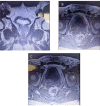Carcinoma in situ within the bladder trigone with an isolated metastasis to the prostate without involvement of prostatic urethra: a unique case report
- PMID: 38879527
- PMCID: PMC11179282
- DOI: 10.1186/s12894-024-01516-6
Carcinoma in situ within the bladder trigone with an isolated metastasis to the prostate without involvement of prostatic urethra: a unique case report
Abstract
Background: Carcinoma in situ of the bladder is a high-grade cancer that originates in the superficial layer of the bladder. It has the potential to invade nearby organs, and it can spread through blood and lymphatic circulation to distant parts of the body.
Case presentation: A 58-year-old non-smoker male presented with gross and microscopic hematuria. His family history included his father's recent bladder cancer. Initial investigations showed hematuria, inflammation, negative urine culture, digital rectal examination revealed an enlarged right lobe of the prostate, and an elevated Prostate-Specific Antigen level. Histopathological examination of samples taken from the bladder mucosa and the prostate confirmed urothelial carcinoma in situ in the bladder and prostate. Further evaluation revealed no other metastasis. The tumor was classified as T4aN0M0. The patient underwent radical cystoprostatectomy and histopathological examination showed that the tumor invading the muscularis propria of the bladder as well as the prostatic glands, but no malignancy was found in prostatic urethra and other areas. The patient was discharged three weeks post-operation and completed on adjuvant chemotherapy consisting of Gemcitabine, and Cisplatin to prevent of relapse. The patient is currently in a good healthy.
Conclusion: The occurrence of bladder cancer metastasizing to the prostate without involving the prostatic urethra is uncommon and requires precise diagnostic techniques for accurate tumor classification. Early management is advised to enhance the prognosis for the patient.
Keywords: Bladder; Carcinoma in Situ; Case Report; Metastasis; Prostate; Prostatic Urethra.
© 2024. The Author(s).
Conflict of interest statement
The authors declare that they have no competing interests.
Figures




Similar articles
-
[Transitional cell carcinoma of the prostate in cystoprostatectomy specimens].Aktuelle Urol. 2003 Sep;34(5):333-6. doi: 10.1055/s-2003-42002. Aktuelle Urol. 2003. PMID: 14566661 German.
-
[Prostatic involvement by urothelial carcinoma in patients with bladder cancer and their implications in the clinical practice].Actas Urol Esp. 2012 Oct;36(9):545-53. doi: 10.1016/j.acuro.2012.02.005. Epub 2012 Apr 19. Actas Urol Esp. 2012. PMID: 22520044 Review. Spanish.
-
The value of bladder mapping and prostatic urethra biopsies for detection of carcinoma in situ (CIS).BJU Int. 2012 Jul;110(2 Pt 2):E41-5. doi: 10.1111/j.1464-410X.2011.10654.x. Epub 2011 Oct 28. BJU Int. 2012. PMID: 22035276
-
Transitional cell carcinoma of the prostate in cystoprostatectomy specimens removed for bladder cancer.J Urol. 1989 Feb;141(2):346-9. doi: 10.1016/s0022-5347(17)40762-2. J Urol. 1989. PMID: 2913357
-
Urothelial carcinoma in the prostatic urethra and prostate: current controversies.Expert Rev Anticancer Ther. 2007 Mar;7(3):383-90. doi: 10.1586/14737140.7.3.383. Expert Rev Anticancer Ther. 2007. PMID: 17338657 Review.
References
-
- MELICOW MM. Histological study of vesical urothelium intervening between gross neoplasms in total cystectomy. J Urol. 1952;68(1):261 – 79. 10.1016/S0022-5347(17)68193-X. PMID: 14939458. - PubMed
Publication types
MeSH terms
LinkOut - more resources
Full Text Sources
Medical

